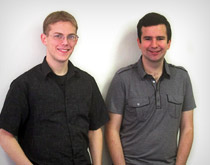Joe Gershenson and Brian Krausz weren't sure whether they could get their idea to work-using webcams to conduct eye-tracking studies, which would help content providers and advertisers figure out where users look on Web sites. They had developed a prototype, but their early studies produced unusable data.

The two partners had met and become friends while they were students at Carnegie Mellon. After they earned their undergraduate degrees in computer science in 2009, Gershenson stayed at school to pursue an MS degree in computer science and Krausz took a job with a travel company observing eye-tracking studies, which required costly hardware to track movements of a user's gaze. In addition, participants had to be tested in a lab setting, which made Krausz wonder whether the results were tainted. It gave him a startup idea-develop a natural, economical way to gather data on web users.
He got Gershenson involved because he had knowledge of computer vision algorithms. The pair worked nights and weekends to develop a webcam prototype. Then they met with Y Combinator, an incubator that provides seed funding to startups. After assuring their interviewers that GazeHawk would succeed in a home environment, they got backing, which also meant making their claim a reality.
After months of coding, testing, and tinkering, they finally had a study where one participant's data stood out. "It was perfect: you could tell exactly how he browsed through the Web site and exactly what he was looking at," recalls Krausz. "We stepped back and thought, 'Wow, this is really possible!'"
Since then, GazeHawk has secured several big-name clients. Both Ad Age and Huffington Post recently named the company to their list of Top 10 Startups to Watch lists.
-Janet Jay (DC'07)



